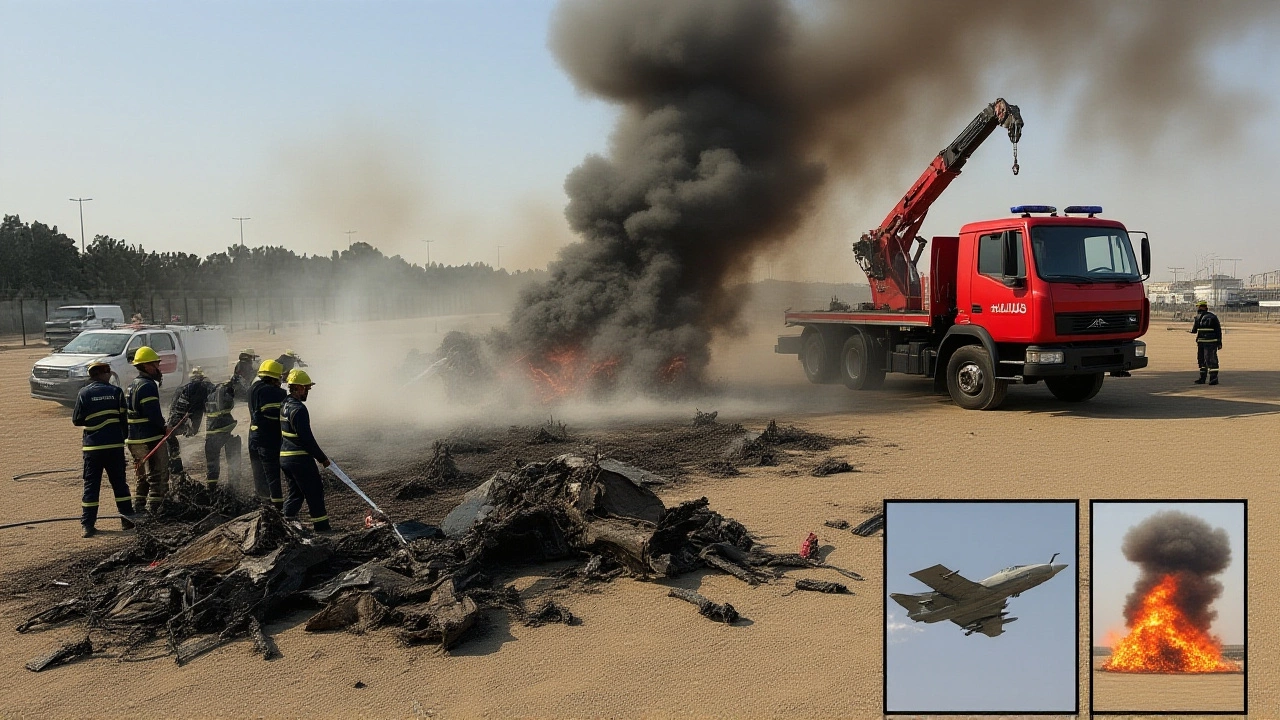A heart-stopping tragedy unfolded at the Dubai Air Show 2025Al Maktoum International Airport on Friday, November 21, 2025, at 2:10:30 PM local time. A Hindustan Aeronautics Limited (HAL) Tejas Light Combat Aircraft, piloted by 34-year-old Wing Commander Namansh Syal of the Indian Air Force (IAF), plunged from the sky during a high-stakes aerobatic display, exploding in a fireball seconds after impact. The crash claimed Syal’s life — the first fatality in the 23-year history of India’s indigenous fighter jet program. Witnesses described the moment the Tejas, performing a negative-G turn at barely 100 feet, suddenly rolled violently, lost all lift, and slammed into the desert sand near the runway. No distress call was made. Just silence, then fire.
What Happened in Those Final Seconds?
Eyewitness footage, later shared widely on social media, showed the Tejas executing a sharp, aggressive maneuver — a hallmark of IAF’s demonstration team — when it abruptly entered an uncontrolled descent. The jet didn’t stall. It didn’t spin. It simply vanished from the sky. According to defense analysts, the negative-G turn, which pulls blood away from the pilot’s brain, is among the most dangerous in the aerobatic repertoire. At such low altitude, recovery is nearly impossible. The aircraft hit the ground at 2:11 PM, less than a minute after the maneuver began. Emergency crews rushed to the smoldering wreckage, but there was no chance of survival.Respect Over Routine: The US Pilot Who Walked Away
While the Dubai Air Show organizers resumed flying just two hours later — a decision that drew global condemnation — Captain Taylor 'Fema' Hiester of the United States Air Force (USAF) made a quiet, powerful choice. His F-16 demonstration team, already prepped for their final performance, canceled their flight. "We watched," Hiester posted on social media. "The ladder was still leaning against the empty jet. His flight suit was still in his rental car. We didn’t need to fly to honor him. We just needed to stop." His statement resonated far beyond the airfield. Pilots from France, Sweden, and even Brazil quietly withdrew their teams. The contrast was stark: one nation continuing its spectacle, another choosing silence over spectacle. "It wasn’t about politics," said a senior British Royal Air Force observer. "It was about recognizing that a man just died doing his job — and that deserves more than a press release."Who Was Wing Commander Namansh Syal?
Syal, a decorated pilot with over 1,200 flight hours, was known for his precision and calm under pressure. He had flown the Tejas in multiple international air shows, including in Singapore and Bahrain. Colleagues described him as "the quiet type who never bragged, but always delivered." His last social media post, just hours before the show, showed him smiling beside the Tejas with the caption: "Making India proud, one roll at a time." His body was repatriated to his hometown in Uttar Pradesh, where he was laid to rest with full military honors. The emotional toll on his family was devastating. According to the Economic Times, his father learned of his death by scrolling through YouTube videos of the air show — the same footage that went viral worldwide. "He was watching his son fly," said a family friend. "And then he saw him fall."
Was It the Plane? The Pilot? Or Something Else?
The Indian Air Force has launched a formal court of inquiry, but no official cause has been released. Defense experts are weighing three possibilities: human error, mechanical failure, or physiological stress. Captain Anil Gaur (Retd.), a former IAF flight test engineer, pointed to G-force-induced blackout. "The Tejas is agile, yes — but its cockpit ergonomics haven’t kept pace with its performance. At negative-G, even experienced pilots can lose peripheral vision. If he blacked out for even 1.5 seconds…" Others point to the jet’s fly-by-wire system, which has had intermittent software glitches in past test flights. No maintenance logs have been made public. And while sabotage is considered extremely unlikely, the fact that the crash occurred during a high-profile international event has fueled speculation. The UAE has not yet released the full flight data recorder results, citing ongoing investigations.What This Means for India’s Defense Ambitions
The Tejas program has been India’s pride project — a symbol of self-reliance in defense manufacturing. Over 150 units have been delivered to the IAF, and export talks are underway with Argentina, Egypt, and the Philippines. But this crash, at the world’s premier air show, has cast a long shadow. Critics are asking: Are we pushing the Tejas too hard, too soon? Are aerobatic displays — meant to impress foreign buyers — worth the risk? "We don’t fly these jets to show off," said retired Air Chief Marshal R. K. Singh. "We fly them to defend. Demonstrations should honor the machine, not endanger the man." The IAF has temporarily grounded all Tejas aerobatic teams pending the inquiry. The next air show in India, scheduled for January in Bengaluru, may be scaled back — or canceled entirely.
What’s Next?
The court of inquiry is expected to take 90 days, with a preliminary report due by late February 2026. Meanwhile, HAL has promised a full systems review. The UAE has offered technical assistance, including access to its advanced flight data analysis center. And the global aviation community is watching — not just for answers, but for accountability. One thing is certain: Wing Commander Namansh Syal won’t be forgotten. His name will be engraved on the IAF’s memorial wall. His family will receive the nation’s highest honors. And future pilots will learn from his final flight — not just how to fly, but when to hold back.Frequently Asked Questions
Was the Tejas jet known to have mechanical issues before this crash?
While the Tejas has had minor software glitches in early test flights, no major mechanical failures had been reported in operational service. The aircraft has completed over 5,000 sorties since its induction in 2016 with a 94% mission readiness rate. However, aerobatic maneuvers push systems beyond standard flight envelopes, and the exact condition of this specific jet’s flight control software is still under review by the IAF inquiry team.
Why did the Dubai Air Show continue flying after the crash?
Organizers cited logistical and contractual obligations with participating nations and sponsors. They stated that continuing the program was "in the interest of all exhibitors and attendees." But critics argue that international air shows have precedent for halting flights after fatal accidents — as seen after the 2015 Kolavia crash in Russia and the 2019 Paris Air Show incident. The decision sparked outrage among participating air forces who viewed it as disrespectful to the fallen pilot.
How common are fatal crashes during air show demonstrations?
Fatal crashes during air shows are rare but not unheard of. Between 1989 and 2025, there were 17 fatal aerobatic accidents globally involving military jets. The most recent before this was in 2021, when a South Korean T-50 pilot died during a performance in Busan. Most occur during low-altitude, high-G maneuvers. The Tejas crash is only the second fatal accident in its 23-year history — and the first during an international air show.
Could Wing Commander Syal have ejected?
The Tejas is equipped with a Martin-Baker ejection seat, fully functional and certified for zero-zero conditions. However, ejection requires split-second decisions and sufficient altitude. In this case, the jet descended from 100 feet to impact in under 1.8 seconds — less time than it takes to pull the ejection handle. Experts say ejection was physically impossible at that point. The aircraft’s black box will confirm whether the system was armed and if any ejection command was initiated.
Will this affect India’s Tejas export deals?
Several potential buyers, including Egypt and Argentina, have requested additional safety documentation and flight data from the IAF inquiry before proceeding. While HAL maintains the Tejas remains a reliable platform, the incident has introduced uncertainty. Export contracts often include performance guarantees and safety records. If the inquiry finds a systemic flaw, it could delay or even derail deals. But if it’s ruled a pilot-specific incident, most nations are expected to continue negotiations.
What changes might the Indian Air Force make after this tragedy?
The IAF is expected to revise its aerobatic display protocols, possibly raising minimum altitudes for negative-G maneuvers from 100 feet to 1,500 feet. There may also be mandatory physiological monitoring for pilots before high-G displays, including G-suit calibration checks and real-time brainwave monitoring. Training for Tejas demonstration teams will likely be centralized under a dedicated safety cell, separate from operational squadrons, to prioritize safety over spectacle.
